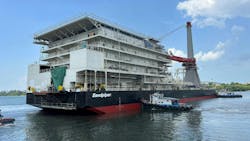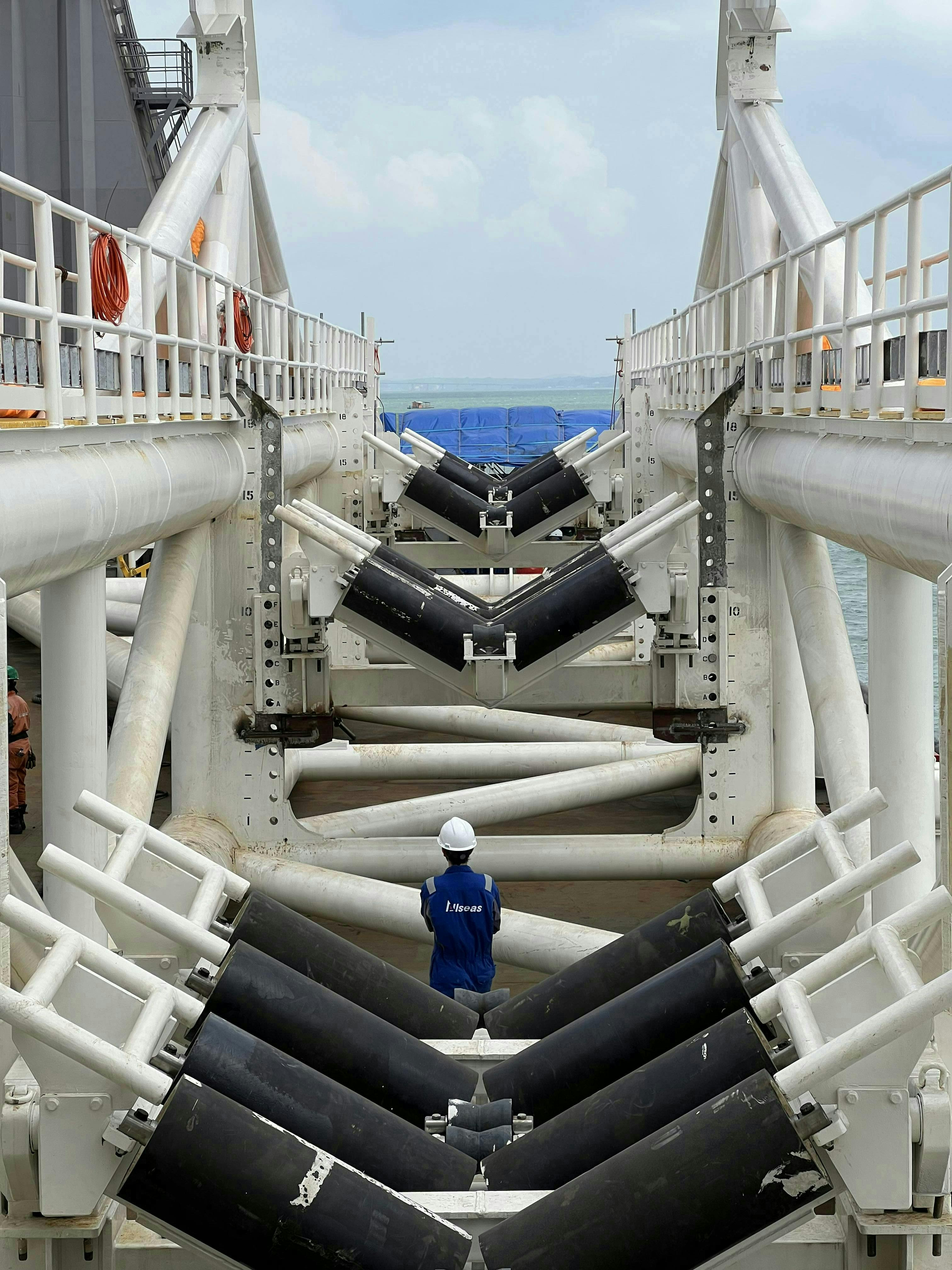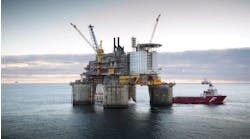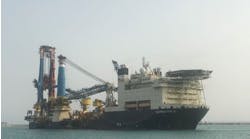Editor's note: This feature article first appeared in the March-April 2024 issue of Offshore magazine. Click here to view the full issue.
By Jeremy Beckman, Editor-Europe
Sea trials started off Singapore last month of Allseas’ Sandpiper, a flat-bottom anchored barge newly converted for shallow-water construction activity. On completion of the test program, the vessel was due to head directly to a neighboring country for its first assignment, a gas export pipeline installation and associated pull-in from the shore.
The investment was driven in part by the resurgence of greenfield developments and brownfield tie-ins across the Far East region and Australia, led by IOCs and majors. But Sandpiper will also be pitched for projects worldwide, working on its own or alongside other Allseas vessels on projects with wider-ranging scopes.
The company had been on the look-out for years for a candidate vessel to replace Tog Mor, another flat-bottom barge built in the late 1990s which Allseas converted for shallow-water pipelay during 2001-02. “We had several projects lined up requiring extensive shallow-water installation scopes when we finally came across the Nand Gaurav,” said Dries van Strijp, VP Operations. It was originally built in China in 2008 as an accommodation and hookup barge for US-based Superior Energy Services. Six years later, an Indian conglomerate purchased the vessel and converted it to a pipelay barge for operations offshore India, adding a firing line with eight workstations and pipelay equipment.
Historically, Allseas has grown its offshore construction fleet via conversions. Lorelay, Solitaire and Audacia are all converted bulk carriers, although Pioneering Spirit is a new build. “It’s a question of time rather than cost,” explained van Strijp. “A conversion can be quite expensive, but the lead time compared with a new build is much shorter, and converting means the asset is available sooner. Based on our work with Tog Mor, the specifications for an additional barge at the right price were quite clear when we acquired Nand Gaurav in July 2022. The length and width, crane capacity and accommodation were all in line with our needs.”
Allseas’ initial intention was to perform a minimal reactivation scope, added Florian Wasser, VP Innovations. “At the time, our project backlog was modest, but it grew significantly within a year, with several upcoming projects comprising significant shallow water/nearshore scopes, such as TC Energy’s Southeast Gateway [a 715-km offshore gas pipeline that will transport 1.3 cf/d to multiple conurbations in central and south-eastern Mexico]. Similarly, our wish list of upgrades expanded: some of the project commitments had certain requirements, for example a piggy-back line in addition to the main firing line.”
After obtaining Nand Gaurav, the company considered yards in the Middle and Far East for the conversion, eventually opting for PaxOcean Singapore due to its capabilities, availability and proximity to where the vessel’s first potential project was.
Around 300 third parties participated in the upgrade design and engineering process to allow Sandpiper to accommodate a state-of-the-art S-lay spread. This included structural strengthening in certain areas. “While reviewing the original stinger design and performing hydrodynamic simulations, it became apparent that the structure wasn’t suitable to cope with the intended environmental conditions,” said Wasser. “In particular, side loading required additional reinforcements by widening the stinger base, and the hinge points had to be renewed.
“Like the vessel itself, much of the equipment is not new. A lot of existing systems had only been used on one pipelay project before like the firing line equipment and the 800-t capacity mast crane. Many of the original suppliers were involved in bringing their systems back online. At the same time, new equipment was added such as two additional winches to expand the positioning capabilities of the mooring system. PaxOcean Singapore performed most of the installation and reactivation works, while Sandpiper was at their yard.”
This is the first vessel in the company’s fleet to be fitted with an in-house developed automated anchor positioning system. The technology was trialled on Audacia a few years ago for nearshore pipelay in the Baltic Sea. Audacia too will undergo a permanent installation early next year. The system is designed to help maximize safety and efficiency when the vessels are operating their anchor mooring spreads in shallow waters.
According to Wasser, “another innovation on Sandpiper is the inclusion of our latest Phoenix automated welding equipment in the firing line, which will soon be joined by our recently introduced Dolphin AUT system based on phased array ultrasonic testing technology, and automated field joint sheet wrapping machine. All are examples of what the company is pursuing to develop safer, a faster and more reliable production flow.”
For mid-line tie-ins, the davits system allows the vessel to connect to the two pipe ends on the seabed. The davits are positioned on the port side. By attaching to pre-installed connection points, the pipeline ends will be raised to the surface close to the side of the barge. An above-water tie-in platform will be installed below the two pipe ends. Once in place, the crew can access the two overlapping pipe ends. Following exact measurements, the laydown heads are cut off and the pipe ends prepared for welding, with an external line-up clamp deployed to align the two pipe ends. Once aligned, the pipe is welded and NDT tested. After approval of the weld, the weld is coated as per project coating requirements. Finally, the platform is removed and the pipeline lowered to the seabed while the barge moves sideways to allow for the over-length to be laid on the seabed.
Sandpiper’s initial clients were due to send representatives to attend the vessel’s sea trials, which included a full test of the mooring system, comprising 10 x 12-t anchors, and the interface with the pipelay equipment, mainly the tensioners; and further tests of the interaction between the Abandonment and Recovery (A&R) winch and the tensioners.
The 170-m (558-ft) long vessel can lay pipes from 8 to 60-in. diameter in water depths of up to 150 m, with a piggyback firing line for 6.5-in. pipe. In the main firing line, there are four workstations for welding, three for coating, one for NDT operations and one more for piggy-back tasks. The offshore mast crane provides a minimum working radius of 8.5 m and a maximum of 52 m. Tog Mor too has a 10-point mooring system and can handle pipes (including piggyback) of similar diameters.
“With Sandpiper,” said Van Strijp, “we believe we are providing best-in-class shallow water pipelay services, which is something the NOCs and IOCs in Southeast Asia are definitely looking for in a market that has been dominated for some time by a few regional players. While Tog Mor is an old barge, it is still very capable of installing pipelines and performing shallow water construction work. It can keep going for a long time to come with the correct maintenance and lifetime extension measures. The amount of work currently foreseen in this market over the next few years will probably allow for both barges to operate simultaneously.”





